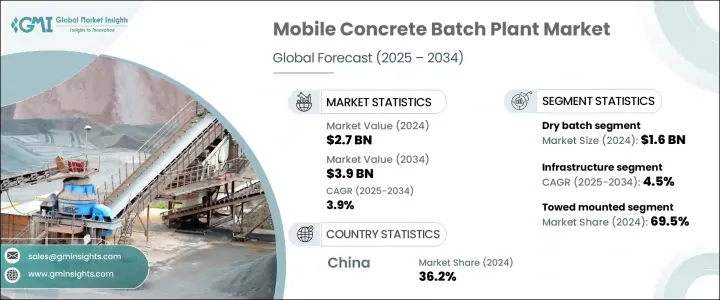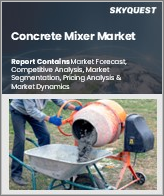
|
시장보고서
상품코드
1740745
이동식 콘크리트 배치 플랜트 시장 기회, 성장 촉진 요인, 산업 동향 분석, 예측(2025-2034년)Mobile Concrete Batch Plant Market Opportunity, Growth Drivers, Industry Trend Analysis, and Forecast 2025 - 2034 |
||||||
이동식 콘크리트 배치 플랜트 세계 시장 규모는 2024년 27억 달러로 평가되었고, CAGR 3.9%로, 2034년에는 39억 달러에 이를 것으로 예측되고 있습니다. 이동식 콘크리트 배치 플랜트는 그 운용의 유연성, 이전의 용이함, 현장에서 콘크리트를 신속하게 대량 생산하는 능력에 의해 이러한 요구에 대응하는데 있어서 필수적인 것이 되고 있습니다. 원격지에서의 작업 환경에 이상적입니다. 도시화가 현대적인 경관을 재구성하는 동안 개발자와 계약자는 지연을 최소화하면서 프로젝트 수요에 대응하는 효율적이고 적응성이 뛰어난 도구를 필요로 합니다. 이를 유지함으로써 정확하게 이를 달성하는 데 도움이 됩니다. 따라서 주요 도로에서부터 소규모 주택 개발에 이르기까지 광범위한 프로젝트에 적합한 솔루션이 되고 있습니다.

시장은 유형별로 건식 배치 시스템과 습식 배치 시스템으로 분류됩니다. 건식 배치 부분은 2024년에 16억 달러의 수익으로 시장을 선도했고 2034년까지 약 3%의 연평균 복합 성장률(CAGR)로 확대될 것으로 예측됩니다. 건식 배치 플랜트가 선호되는 이유는 조작이 쉽고 비용 효율적이고 기동성이 높기 때문입니다. 이 시스템은 시멘트, 골재 및 물을 공장이 아닌 건설 현장에서 결합하여 작동하여 설치 필요성을 줄이고 신속한 시공을 가능하게합니다. 이 방법은 복잡한 혼합 장치가 필요 없기 때문에 초기 투자를 줄이고 유지 보수도 쉽습니다. 가벼운 구조와 최소한의 기계 부품으로 인해 드라이빙 장치는 신속한 재배치와 최소한의 인프라가 필요한 작업에 특히 적합합니다. 이 플랜트는 또한 유틸리티에 대한 액세스가 제한된 원격지 및 임시 환경에서도 효율적으로 작동하고 변동하는 현장에서 일하는 계약자에게 실용적인 솔루션을 제공합니다.
| 시장 범위 | |
|---|---|
| 시작 연도 | 2024년 |
| 예측 연도 | 2025-2034년 |
| 시작 금액 | 27억 달러 |
| 예측 금액 | 39억 달러 |
| CAGR | 3.9% |
용도별로는 인프라 분야가 2024년 시장 점유율의 39.4% 이상을 차지했고 2034년까지의 CAGR은 4.5%를 넘을 것으로 예측되고 있습니다. 인프라 개발 프로젝트는 종종 대량의 콘크리트를 포함하고 연장된 일정에 걸쳐 진행되므로 이동식 배치 장치가 이상적인 선택이 됩니다. 고정공급이 요구되어 고정식 배치 플랜트가 실행 불가능한 지역에서 발생하는 경우가 많습니다.
이동성의 관점에서 시장은 트레일러 탑재형과 견인형으로 나뉩니다. 2024년 시장 점유율은 견인형이 69.5%를 차지했습니다. 간소화되어 작업간의 다운타임이 단축되기 때문에 엄격한 납기로 작업하는 계약자에게 유연성이 높아집니다.
아시아태평양은 세계 시장을 선도하고, 2024년에는 중국에서만 약 5억 달러의 수익을 올렸으며, 약 6.2% 시장 점유율을 차지했습니다. 신규 개발을 추진하고 있으며, 프로젝트의 위치 이동에 대응할 수 있는 신속하고 기동적인 콘크리트 솔루션에 대한 강한 수요가 탄생하고 있습니다.
경쟁사는 대규모 기업이 세계 시장 경쟁의 40%에서 55%를 차지하고 있습니다. 지속적인 투자, 환경적 적합성을 위한 제품 업그레이드, 종합적인 판매 후 지원은 모두 시장 리더십에 기여합니다.
목차
제1장 조사 방법과 범위
제2장 주요 요약
제3장 업계 인사이트
- 생태계 분석
- 밸류체인에 영향을 주는 요인
- 이익률 분석
- 혁신
- 장래의 전망
- 제조업자
- 리셀러
- 트럼프 정권의 관세 분석
- 무역에 미치는 영향
- 무역량의 혼란
- 보복 조치
- 업계에 미치는 영향
- 공급측의 영향(원재료)
- 주요 원재료의 가격 변동
- 공급망 재구성
- 생산 비용에 미치는 영향
- 수요측의 영향(판매가격)
- 최종 시장에의 가격 전달
- 시장 점유율 동향
- 소비자의 반응 패턴
- 영향을 받는 주요 기업
- 전략적인 업계 대응
- 공급망 재구성
- 가격 설정 및 제품 전략
- 정책관여
- 전망과 향후 검토 사항
- 무역에 미치는 영향
- 영향요인
- 급속한 도시화와 인프라 개발
- 신흥 시장 수요 증가
- 인프라 프로젝트 증가
- 업계의 잠재적 위험 및 과제
- 초기 자본 투자액이 높아
- 규제와 환경의 제약
- 성장 가능성 분석
- Porter's Five Forces 분석
- PESTEL 분석
제4장 경쟁 구도
- 소개
- 기업의 시장 점유율 분석
- 경쟁 포지셔닝 매트릭스
- 전략적 전망 매트릭스
제5장 시장 추정 및 예측 : 유형별, 2021년-2034년
- 주요 동향
- 건조 배치
- 젖은 배치
제6장 시장 추정 및 예측 : 용량별, 2021년-2034년
- 주요 동향
- 50 m3/h 이하
- 50-100 m3/h
- 100 m3/h 이상
제7장 시장 추정 및 예측 : 모빌리티별, 2021년-2034년
- 주요 동향
- 트레일러 탑재형
- 견인식
제8장 시장 추정 및 예측 : 자동화별, 2021년-2034년
- 주요 동향
- 전자동
- 반자동
제9장 시장 추정 및 예측 : 믹서 유형별, 2021년-2034년
- 주요 동향
- 트윈 샤프트
- 빵
- 행성
- 기타
제10장 시장 추정 및 예측 : 용도별, 2021년-2034년
- 주요 동향
- 주택용
- 상업용
- 인프라
- 산업
제11장 시장 추정 및 예측 : 지역별, 2021년-2034년
- 주요 동향
- 북미
- 미국
- 캐나다
- 유럽
- 영국
- 독일
- 프랑스
- 이탈리아
- 스페인
- 러시아
- 아시아태평양
- 중국
- 인도
- 일본
- 호주
- 한국
- 라틴아메리카
- 브라질
- 멕시코
- 중동 및 아프리카
- 아랍에미리트(UAE)
- 남아프리카
- 사우디아라비아
제12장 기업 프로파일
- Aimix Group
- Astec Industries
- BHS-Sonthofen Group
- CIFA
- Liebherr Group
- Lyroad
- McCrory Engineering
- Meka
- Odisa Concrete Equipment
- Putzmeister
- Rapid International
- Sany Group
- Semix Global
- Stephens Manufacturing
- Vince Hagan
The Global Mobile Concrete Batch Plant Market was valued at USD 2.7 billion in 2024 and is estimated to grow at a CAGR of 3.9% to reach USD 3.9 billion by 2034. This growth is being driven largely by the increasing pace of urban expansion and rising infrastructure development across both developed and emerging economies. As urban centers continue to grow and population densities increase, there is a greater demand for housing, transportation networks, and public utilities. Mobile concrete batching plants are becoming essential in addressing these needs due to their operational flexibility, ease of relocation, and ability to quickly produce concrete in high volumes on-site. Unlike stationary plants, mobile units can be transported and set up in various locations with minimal downtime, making them ideal for large-scale projects and remote work environments. As urbanization reshapes modern landscapes, developers and contractors require efficient, adaptable tools that keep up with project demands while minimizing delays. Mobile batching plants help achieve just that by reducing setup time, cutting transportation costs, and ensuring a consistent concrete supply wherever needed. This makes them a preferred solution for projects that range from major roads to smaller residential developments. Official data shows that areas undergoing rapid development are experiencing rising adoption of mobile batching systems, reinforcing their relevance in today's construction ecosystem.

Based on type, the market is categorized into dry batch and wet batch systems. The dry batch segment led the market in 2024 with revenue of USD 1.6 billion and is forecasted to expand at a CAGR of around 3% through 2034. Dry batch plants are favored because they are simple to operate, cost-efficient, and highly mobile. These systems function by combining cement, aggregates, and water at the construction site rather than at the plant, reducing setup requirements and allowing for faster installation. This method eliminates the need for complex mixing equipment, leading to lower initial investment and easier maintenance. Their lightweight structure and minimal mechanical components make dry batch units particularly suited for operations that need rapid relocation and minimal infrastructure. These plants also operate efficiently in remote or temporary settings where access to utilities is limited, offering a practical solution for contractors working on variable job sites.
| Market Scope | |
|---|---|
| Start Year | 2024 |
| Forecast Year | 2025-2034 |
| Start Value | $2.7 Billion |
| Forecast Value | $3.9 Billion |
| CAGR | 3.9% |
From an application standpoint, the infrastructure segment accounted for over 39.4% of the market share in 2024 and is anticipated to grow at a CAGR exceeding 4.5% by 2034. Infrastructure development projects often involve large volumes of concrete and span extended timelines, making mobile batching units an ideal choice. These projects demand consistent, on-demand concrete delivery and often occur in regions where fixed batching plants are not feasible. The ability of mobile units to adapt to diverse site conditions and produce concrete without the logistical burden of fixed infrastructure allows them to meet strict deadlines and operational requirements. The rise in public and private infrastructure spending globally is significantly contributing to this segment's dominance in the overall market.
In terms of mobility, the market is split into trailer-mounted and towed-mounted configurations. The towed-mounted segment held a commanding 69.5% market share in 2024. These systems stand out due to their ease of transport and setup, as they can be towed between sites without full disassembly. Their wheel-mounted design simplifies relocation and reduces downtime between jobs, offering greater flexibility for contractors working under tight deadlines. Towed-mounted units require minimal site preparation and can be assembled or taken down in a matter of hours. Their efficient mobility makes them especially popular in fast-paced construction zones where speed and adaptability are critical.
Asia-Pacific led the global market, with China alone generating approximately USD 500 million in revenue and holding around 6.2% market share in 2024. The region's growth is underpinned by a surge in investment toward residential, commercial, and industrial construction. Governments and private developers alike are pushing forward with new developments, creating strong demand for quick, mobile concrete solutions that can keep up with shifting project locations. Favorable regulations, growing construction budgets, and increased foreign investments are further supporting this upward trend.
On the competitive front, major players jointly account for between 40% and 55% of the global mobile concrete batch plant market. These companies leverage extensive manufacturing and distribution networks to serve varied regional demands efficiently. Their reputation for reliable engineering and consistent product performance allows them to maintain strong client relationships and secure large-scale contracts. Continuous investment in R&D, product upgrades for environmental compliance, and comprehensive after-sales support all contribute to their market leadership. Strategic partnerships and acquisitions help extend their global footprint, while integrated training and service offerings further boost customer loyalty and operational uptime.
Table of Contents
Chapter 1 Methodology & Scope
- 1.1 Research design
- 1.1.1 Research approach
- 1.1.2 Data collection methods
- 1.2 Base estimates and calculations
- 1.2.1 Base year calculation
- 1.2.2 Key trends for market estimates
- 1.3 Forecast model
- 1.4 Primary research & validation
- 1.4.1 Primary sources
- 1.4.2 Data mining sources
- 1.5 Market definitions
Chapter 2 Executive Summary
- 2.1 Industry synopsis, 2021 - 2034
Chapter 3 Industry Insights
- 3.1 Industry ecosystem analysis
- 3.1.1 Factors affecting the value chain
- 3.1.2 Profit margin analysis
- 3.1.3 Disruptions
- 3.1.4 Future outlook
- 3.1.5 Manufacturers
- 3.1.6 Distributors
- 3.2 Trump administration tariffs analysis
- 3.2.1 Impact on trade
- 3.2.1.1 Trade volume disruptions
- 3.2.1.2 Retaliatory measures
- 3.2.2 Impact on the industry
- 3.2.2.1 Supply-side impact (raw materials)
- 3.2.2.2 Price volatility in key materials
- 3.2.2.3 Supply chain restructuring
- 3.2.2.4 Production cost implications
- 3.2.2.5 Demand-side impact (selling price)
- 3.2.2.6 Price transmission to end markets
- 3.2.2.7 Market share dynamics
- 3.2.2.8 Consumer response patterns
- 3.2.3 Key companies impacted
- 3.2.4 Strategic industry responses
- 3.2.4.1 Supply chain reconfiguration
- 3.2.4.2 Pricing and product strategies
- 3.2.4.3 Policy Engagement
- 3.2.5 Outlook and future considerations
- 3.2.1 Impact on trade
- 3.3 Impact forces
- 3.3.1 Rapid urbanization and infrastructure development
- 3.3.2 Growing demand in emerging markets
- 3.3.3 Increasing infrastructure projects
- 3.4 Industry pitfalls & challenges
- 3.4.1 High initial capital investment
- 3.4.2 Regulatory and environmental constraints
- 3.5 Growth potential analysis
- 3.6 Porter's analysis
- 3.7 PESTEL analysis
Chapter 4 Competitive Landscape, 2024
- 4.1 Introduction
- 4.2 Company market share analysis
- 4.3 Competitive positioning matrix
- 4.4 Strategic outlook matrix
Chapter 5 Market Estimates & Forecast, By Type, 2021 - 2034 ($Bn) (Thousand Units)
- 5.1 Key trends
- 5.2 Dry batch
- 5.3 Wet batch
Chapter 6 Market Estimates & Forecast, By Capacity, 2021 - 2034 ($Bn) (Thousand Units)
- 6.1 Key trends
- 6.2 Below 50 m³/h
- 6.3 50–100 m³/h
- 6.4 Above 100 m³/h
Chapter 7 Market Estimates & Forecast, By Mobility, 2021 - 2034 ($Bn) (Thousand Units)
- 7.1 Key trends
- 7.2 Trailer-Mounted
- 7.3 Towed-Mounted
Chapter 8 Market Estimates & Forecast, By Automation, 2021 - 2034 ($Bn) (Thousand Units)
- 8.1 Key trends
- 8.2 Fully automatic
- 8.3 Semi-automatic
Chapter 9 Market Estimates & Forecast, By Mixer Type, 2021 - 2034 ($Bn) (Thousand Units)
- 9.1 Key trends
- 9.2 Twin Shaft
- 9.3 Pan
- 9.4 Planetary
- 9.5 Others
Chapter 10 Market Estimates & Forecast, By Application, 2021 - 2034 ($Bn) (Thousand Units)
- 10.1 Key trends
- 10.2 Residential
- 10.3 Commercial
- 10.4 Infrastructure
- 10.5 Industrial
Chapter 11 Market Estimates & Forecast, By Region, 2021 - 2034 ($Bn) (Thousand Units)
- 11.1 Key trends
- 11.2 North America
- 11.2.1 U.S.
- 11.2.2 Canada
- 11.3 Europe
- 11.3.1 UK
- 11.3.2 Germany
- 11.3.3 France
- 11.3.4 Italy
- 11.3.5 Spain
- 11.3.6 Russia
- 11.4 Asia Pacific
- 11.4.1 China
- 11.4.2 India
- 11.4.3 Japan
- 11.4.4 Australia
- 11.4.5 South Korea
- 11.5 Latin America
- 11.5.1 Brazil
- 11.5.2 Mexico
- 11.6 MEA
- 11.6.1 UAE
- 11.6.2 South Africa
- 11.6.3 Saudi Arabia
Chapter 12 Company Profiles
- 12.1 Aimix Group
- 12.2 Astec Industries
- 12.3 BHS-Sonthofen Group
- 12.4 CIFA
- 12.5 Liebherr Group
- 12.6 Lyroad
- 12.7 McCrory Engineering
- 12.8 Meka
- 12.9 Odisa Concrete Equipment
- 12.10 Putzmeister
- 12.11 Rapid International
- 12.12 Sany Group
- 12.13 Semix Global
- 12.14 Stephens Manufacturing
- 12.15 Vince Hagan



















